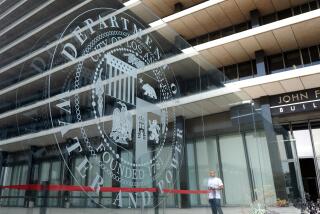Newton: DWP’s new general manager is on the hot seat
The view from the top floor of the Los Angeles Department of Water and Power testifies to its place in the life and history of the city. To the north and west are Silver Lake and the Hollywood Hills, dotted with reservoirs that define neighborhoods and store water; over the horizon lies the San Fernando Valley, made possible when the DWP grabbed water from the Owens Valley and brought it to Los Angeles. And to the southeast sits City Hall. Notably, the seat of city government is at the bottom of the hill; the DWP is at the top.
Today, that agency is under new leadership and facing a combination of new and familiar challenges. The DWP faces state mandates for renewable energy; obligations to restore Owens Lake (site of the great water heist in the early 20th century); increasing claims on its most expensive source of water, the Colorado River; and an aging collection of water mains and power poles badly in need of replacement. The solution to many of those new demands is painfully obvious: rate hikes.
The man in the unenviable position of convincing city residents and businesses that paying more is in their interest is the DWP’s recently appointed general manager, Ron Nichols. Lanky and laconic, blunt and yet amiable, Nichols comes to the job with more than 35 years of experience in electric power, and he has survived bruising rate battles before. Over the next few months, though, he’s going to get his first taste of the peculiar and infuriating politics of Los Angeles. Other industry leaders worry that the DWP’s problems have been too long deferred and that its rate-setting process has been so politicized that Nichols is in for a rough patch.
Last week, Nichols freely acknowledged the challenge before him: to upgrade the DWP’s many systems at a time when most elected officials would rather not talk about rate increases, even the modest ones he’s proposing. “Are these political issues?” he asked rhetorically. “Of course they are.”
To educate the public on the choices before it, Nichols has been hosting meetings across town. Invariably, he said, the first reaction is resistance. Some residents arrive “pounding the table” and pleading: “I’m paying too much already. How can you think of raising my rates? Don’t you know what shape the economy is in?”
But then Nichols turns to the realities. By law, the DWP must procure a third of its energy from renewable resources by 2020; it is required to ease out of coal and replace cooling systems at its power plants that draw in seawater. It’s being forced to put caps on open reservoirs, and it’s trying to create incentives for residents to conserve water. And then there’s infrastructure. At today’s rates, the DWP can afford to replace water mains every 340 years; they were built to last a century.
Moreover, Los Angeles residents, despite their often-frenzied response to proposed rate hikes, pay less for water and power than just about anyone else in California.
Nichols has adopted an approach to this year’s rate follies that has the dual advantage of being clear and open, two characteristics not often associated with the DWP. As Nichols makes clear, the legally mandated costs will push up water rates by about 15% over the next three years and electricity rates by a bit more (for a typical resident, that’s about $2 more a month for water in the first year, then $4, then $6; for electric users, it means an increase of $4 a month the first year, then $8, then $12.). After that, though, residents and their elected officials can choose: Do we want to invest in capturing more storm water and recycled water? If so, add an additional 22 cents a month in the first year. How about funding a refrigerator exchange program and other investments to reduce energy use? That’ll cost 20 cents a month.
In the long run, those investments would make Los Angeles cleaner and reduce future increases in energy costs. But the long run is the rub in local politics. There are few easier ways for elected officials to make cheap points than to protest rate increases. City Council members love to play to the crowd, and Mayor Antonio Villaraigosa, though a staunch believer in cleaner energy, is not exactly at the high-water mark of his influence. There’s not much Nichols can do about that, so he’s left with candor.
“I have a bothersome tendency to be open and honest,” he said last week. “Facts count.”
Let’s hope.
More to Read
A cure for the common opinion
Get thought-provoking perspectives with our weekly newsletter.
You may occasionally receive promotional content from the Los Angeles Times.











